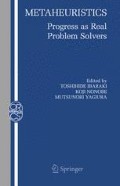Abstract
Elevator supervisory group control (ESGC) is a complex combinatorial optimization task that can be solved by modern search heuristics. To reduce its complexity and to enable a theoretical analysis, a simplified ESGC model (S-ring) is proposed. The S-ring has many desirable properties: Fast evaluation, reproducibility, scalability, and extensibility. It can be described as a Markov decision process and thus be analyzed theoretically and numerically. Algorithm based validation (ABV), as a new methodology for the validation of simulation models, is introduced. Based on ABV, we show that the S-ring is a valid ESGC model. Finally, the extensibility of the S-ring model is demonstrated.
Access this chapter
Tax calculation will be finalised at checkout
Purchases are for personal use only
Preview
Unable to display preview. Download preview PDF.
References
Arnold, D.V. and Beyer, H.-G. (2003). A comparison of evolution strategies with other direct search methods in the presence of noise. Computational Optimization and Applications, 24(1).
Banks, J., Carson, J. S., Nelson, B. L., and Nicol, D. M. (2001). Discrete Event System Simulation. Prentice Hall.
Barney, G. (1986). Elevator Traffic Analysis, Design and Control. Cambridge U.P.
Bartz-Beielstein, T. and Markon, S. (2004). Tuning search algorithms for real-world applications: A regression tree based approach. In Proceedings of the 2004 IEEE Congress on Evolutionary Computation, pages 1111–1118, Portland, Oregon. IEEE Press.
Bartz-Beielstein, T., Parsopoulos, K. E., and Vrahatis, M. N. (2004). Analysis of particle swarm optimization using computational statistics. In Simos, T. E. and Tsitouras, Ch., editors, International Conference on Numerical Analysis and Applied Mathematics 2004 (IC-NAAM), pages 34–37. European Society of Computational Methods in Science and Engineering (ESCMSE), Wiley.
Beielstein, T., Ewald, C.-P., and Markon, S. (2003a). Optimal elevator group control by evolution strategies. In Cantú-Paz, E., Foster, J. A., Deb, K., Davis, L. D., Roy, R., O’Reilly, U.-M., Beyer, Hans-Georg, et al., editors, Proc. Genetic and Evolutionary Computation Conf. (GECCO 2003), Chicago IL, Part II, volume 2724 of Lecture Notes in Computer Science, pages 1963–1974, Berlin. Springer.
Beielstein, T. and Markon, S. (2002). Threshold selection, hypothesis tests, and DOE methods. In Fogel, David B., El-Sharkawi, Mohamed A., Yao, Xin, Greenwood, Garry, Iba, Hitoshi, Marrow, Paul, and Shackleton, Mark, editors, Proceedings of the 2002 Congress on Evolutionary Computation CEC2002, pages 777–782. IEEE Press.
Beielstein, T., Markon, S., and Preuß, M. (2003b). Algorithm based validation of a simplified elevator group controller model. In Ibaraki, T., editor, Proc. 5th Metaheuristics Int’l Conf. (MIC’03), pages 06/1–06/13 (CD-ROM), Kyoto, Japan.
Beielstein, T., Markon, S., and Preuβ, M. (2003c). A parallel approach to elevator optimization based on soft computing. In Ibaraki, T., editor, Proc. 5th Metaheuristics Int’l Conf. (MIC’03), pages 07/1–07/11 (CD-ROM), Kyoto, Japan.
Crites, R.H. and Barto, A.G. (1998). Elevator group control using multiple reinforcement learning agents. Machine Learning, 33(2–3):235–262.
François, O. and Lavergne, C. (2001). Design of evolutionary algorithms — a statistical perspective. IEEE Transactions on Evolutionary Computation, 5(2):129–148.
Howard, R. A. (1972). Dynamic Programming and Markov Processes. MIT Press, 7th edition.
Law, A.M. and Kelton, W.D. (2000). Simulation Modelling and Analysis. McGraw-Hill, New York, 3rd edition.
Markon, S. (1995). Studies on Applications of Neural Networks in the Elevator System. PhD thesis, Kyoto University.
Markon, S., Arnold, D.V., Bäck, T., Beielstein, T., and Beyer, H.-G. (2001). Thresholding — a selection operator for noisy ES. In Kim, J.-H., Zhang, B.-T., Fogel, G., and Kuscu, I., editors, Proc. 2001 Congress on Evolutionary Computation (CEC’01), pages 465–472, Seoul, Korea. IEEE Press, Piscataway NJ.
Markon, S. and Nishikawa, Y. (2002). On the analysis and optimization of dynamic cellular automata with application to elevator control. The 10th Japanese-German Seminar, Nonlinear Problems in Dynamical Systems, Theory and Applications. Noto Royal Hotel, Hakui, Ishikawa, Japan.
McCullagh, P. and Nelder, J.A. (1989). Generalized Linear Models. Chapman and Hall, 2nd edition.
Naudts, B. and Kallel, L. (2000). A comparison of predictive measures of problem difficulty in evolutionary algorithms. IEEE Transactions on Evolutionary Computation, 4(1):1–15.
Naylor, T.H. and Finger, J.M. (1967). Verification of computer simulation models. Management Science, 2:B92–B101.
Reeves, C.R. and Yamada, T. (1998). Genetic algorithms, path relinking and the flowshop sequencing problem. Evolutionary Computation journal (MIT press), 6(1):230–234.
Schwefel, H.-P., Wegener, I., and Weinert, K., editors (2003). Advances in Computational Intelligence — Theory and Practice. Natural Computing Series. Springer, Berlin.
So, A.T. and Chan, W.L. (1999). Intelligent Building Systems. Kluwer A.P.
Som, T. K. and Sargent, R. G. (1989). A formal development of event graphs as an aid to structured and efficient simulation programs. ORSA J. Comp.
Whitley, D., Watson, J.P., Howe, A., and Barbulescu, L. (2002). Testing, evaluation and performance of optimization and learning systems. Technical report, The GENITOR Research Group in Genetic Algorithms and Evolutionary Computation, Colorado State University.
Wolpert, D.H. and Macready, W.G. (1997). No free lunch theorems for optimization. IEEE Transactions on Evolutionary Computation, 1(1):67–82.
Author information
Authors and Affiliations
Editor information
Editors and Affiliations
Rights and permissions
Copyright information
© 2005 Springer Science+Business Media, Inc.
About this chapter
Cite this chapter
Bartz-Beielstein, T., Preuss, M., Markon, S. (2005). Validation and Optimization of an Elevator Simulation Model with Modern Search Heuristics. In: Ibaraki, T., Nonobe, K., Yagiura, M. (eds) Metaheuristics: Progress as Real Problem Solvers. Operations Research/Computer Science Interfaces Series, vol 32. Springer, Boston, MA. https://doi.org/10.1007/0-387-25383-1_5
Download citation
DOI: https://doi.org/10.1007/0-387-25383-1_5
Publisher Name: Springer, Boston, MA
Print ISBN: 978-0-387-25382-4
Online ISBN: 978-0-387-25383-1
eBook Packages: Mathematics and StatisticsMathematics and Statistics (R0)

